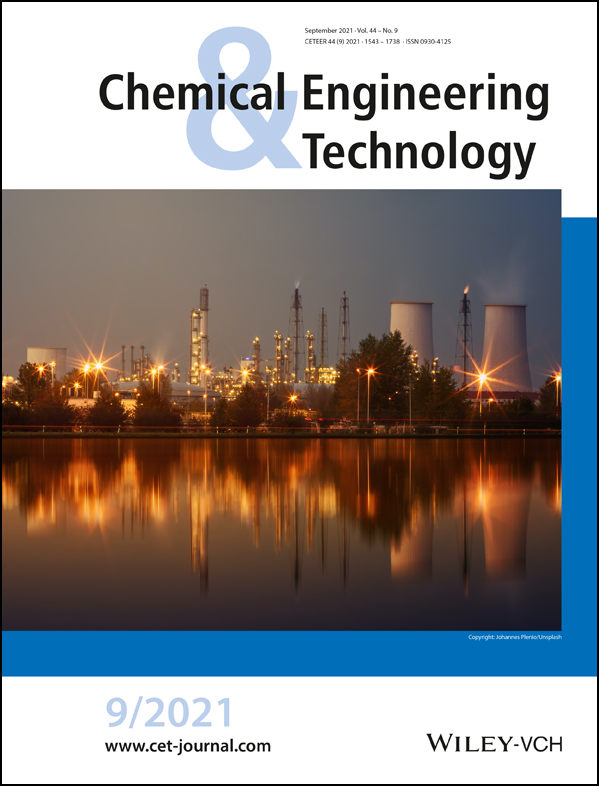Synthesis of Activated Carbon Using Bagasse and Recycled Carbon Fibers
Corresponding Author
Tetsuya Yamamoto
Nagoya University, Department of Chemical Systems Engineering, Furo-cho, Chikusa-ku, 464-8603 Nagoya, Japan
Correspondence: Tetsuya Yamamoto ([email protected]), Nagoya University, Department of Chemical Systems Engineering, Furo-cho, Chikusa-ku, Nagoya, 464-8603, Japan.Search for more papers by this authorYuta Makino
Nagoya University, Department of Materials and Design Innovation Engineering, Furo-cho, Chikusa-ku, 464-8603 Nagoya, Japan
Search for more papers by this authorToshihira Irisawa
Nagoya University, Department of Chemical Systems Engineering, Furo-cho, Chikusa-ku, 464-8603 Nagoya, Japan
Search for more papers by this authorCorresponding Author
Tetsuya Yamamoto
Nagoya University, Department of Chemical Systems Engineering, Furo-cho, Chikusa-ku, 464-8603 Nagoya, Japan
Correspondence: Tetsuya Yamamoto ([email protected]), Nagoya University, Department of Chemical Systems Engineering, Furo-cho, Chikusa-ku, Nagoya, 464-8603, Japan.Search for more papers by this authorYuta Makino
Nagoya University, Department of Materials and Design Innovation Engineering, Furo-cho, Chikusa-ku, 464-8603 Nagoya, Japan
Search for more papers by this authorToshihira Irisawa
Nagoya University, Department of Chemical Systems Engineering, Furo-cho, Chikusa-ku, 464-8603 Nagoya, Japan
Search for more papers by this authorAbstract
Activated carbon was prepared using bagasse and carbon fiber (RCF) recycled from carbon fiber reinforced polymer (CFRP). The RCF surface has a sufficient amount of functional groups and can be used as a catalyst for the hydrolysis of bagasse cellulose. An RCF-bagasse composite was fabricated by ultrasonic irradiation. During cellulose hydrolysis, carbon from the bagasse was activated with sulfuric acid, which impregnated the cellulose pores. When bagasse was subjected to high temperatures, the impregnated pores decomposed, resulting in micropores. The addition of RCF increased the specific surface area of activated carbon by up to 20 % when heat treatment was performed at a temperature higher than the carbonization temperature of bagasse.
Supporting Information
| Filename | Description |
|---|---|
| ceat202100235-sup-0001-misc_information.pdf935.1 KB | Supplementary Information |
Please note: The publisher is not responsible for the content or functionality of any supporting information supplied by the authors. Any queries (other than missing content) should be directed to the corresponding author for the article.
References
- 1 A. Lefeuvre, S. Garnier, L. Jacquemin, B. Pillain, G. Sonnemann, Resour. Conserv. Recycl. 2017, 125, 264–272. DOI: https://doi.org/10.1016/j.resconrec.2017.06.023
- 2 S. Kim, B. E. Dale, Biomass Bioenergy 2004, 26 (4), 361–375. DOI: https://doi.org/10.1016/j.biombioe.2003.08.002
- 3 N. Boonmee, P. Pongsamana, Eng. J. 2017, 21 (3), 37–50. DOI: https://doi.org/10.4186/ej.2017.21.3.37
- 4 Y. W. Han, E. A. Catalano, A. Ciegler, J. Agric. Food Chem. 1983, 31 (1), 34–38. DOI: https://doi.org/10.1021/jf00115a009
- 5 E. Heredia-Olea, E. Perez-Carrillo, S. O. Serna-Saldivar, Bioresour. Technol. 2012, 119, 216–223. DOI: https://doi.org/10.1016/j.biortech.2012.05.122
- 6 F. B. Liang, Y. L. Song, C. P. Huang, J. Zhang, B. H. Chen, Catal. Commun. 2013, 40, 93–97. DOI: https://doi.org/10.1016/j.catcom.2013.06.005
- 7 H. Kobayashi, M. Yabushita, J.-y. Hasegawa, A. Fukuoka, J. Phys. Chem. C 2015, 119 (36), 20993–20999. DOI: https://doi.org/10.1021/acs.jpcc.5b06476
- 8 L. Gan, J. Zhu, L. Lv, Cellulose 2017, 24 (12), 5327–5339. DOI: https://doi.org/10.1007/s10570-017-1515-3
- 9 Z. R. Yue, W. Jiang, L. Wang, S. D. Gardner, C. U. Pittman, Carbon 1999, 37 (11), 1785–1796. DOI: https://doi.org/10.1016/s0008-6223(99)00047-0
- 10 T. Yamamoto, K. Uematsu, T. Irisawa, Y. Tanabe, J. Adhes. 2017, 93 (12), 943–948. DOI: https://doi.org/10.1080/00218464.2016.1189332
- 11 G. Oliveux, L. O. Dandy, G. A. Leeke, Prog. Mater. Sci. 2015, 72, 61–99. DOI: https://doi.org/10.1016/j.pmatsci.2015.01.004
- 12 T. Yamamoto, Y. Makino, K. Uematsu, Adv. Powder Technol. 2017, 28 (10), 2774–2778. DOI: https://doi.org/10.1016/j.apt.2017.08.003
- 13 T. Yamamoto, S. Yabushita, T. Irisawa, Y. Tanabe, Compos. Sci. Technol. 2019, 181, 107665. 107665. DOI: https://doi.org/10.1016/j.compscitech.2019.05.022
- 14 P.-y. C. J.-H. Zhu, M.-n. Su, C. Peia, F. Xing, Green Chem. 2019, 21, 1635–1647. DOI: https://doi.org/10.1039/c8gc03672a
- 15 Y. Xiaochun, Y. Youhua, F. Yanhong, Z. Guizhen, W. Jinsong, Adv. Polym. Technol. 2018, 37 (8), 3861–3872. DOI: https://doi.org/10.1002/adv.22169
- 16 E. Lafranche, P. Krawczak, J. P. Ciolczyk, J. Maugey, eXPRESS Polym. Lett. 2007, 1 (7), 456–466. DOI: https://doi.org/10.3144/expresspolymlett.2007.64
- 17 A. Kelly, W. R. Tyson, J. Mech. Phys. Solids 1965, 13 (6), 329–350. DOI: https://doi.org/10.1016/0022-5096(65)90035-9
- 18 Y. B. Xiao, Y. Z. Xu, K. Y. Zhang, X. N. Tang, J. Huang, K. Yuan, Y. W. Chen, Carbon 2020, 160, 80–87. DOI: https://doi.org/10.1016/j.carbon.2020.01.017
- 19 J. Wang, Y. Xu, B. Ding, Z. Chang, X. Zhang, Y. Yamauchi, K. C. Wu, Angew. Chem. Int. Ed. 2018, 57 (11), 2894–2898. DOI: https://doi.org/10.1002/anie.201712959
- 20 S. Dutta, J. Kim, Y. Ide, J. H. Kim, M. S. A. Hossain, Y. Bando, Y. Yamauchi, K. C. W. Wu, Mater. Horizons 2017, 4 (4), 522–545. DOI: https://doi.org/10.1039/c6mh00500d
- 21 D. Mohan, K. P. Singh, Water Res. 2002, 36 (9), 2304–2318. DOI: https://doi.org/10.1016/s0043-1354(01)00447-x
- 22 S. Brunauer, P. H. Emmett, E. Teller, J. Am. Chem. Soc. 1938, 60, 309–319. DOI: https://doi.org/10.1021/ja01269a023
- 23
J. Xia, K. Noda, N. Wakao, S. Kagawa, Nippon Kagaku Kaishi
2000, 4, 273–280. DOI: https://doi.org/10.1246/nikkashi.2000.273
10.1246/nikkashi.2000.273 Google Scholar
- 24 H. P. Boehm, Carbon 2002, 40 (2), 145–149. DOI: https://doi.org/10.1016/S0008-6223(01)00165-8
- 25 H. P. Boehm, Carbon 1994, 32 (5), 759–769. DOI: https://doi.org/10.1016/0008-6223(94)90031-0
- 26 H. Guedidi, L. Reinert, J.-M. Lévêque, Y. Soneda, N. Bellakhal, L. Duclaux, Carbon 2013, 54, 432–443. DOI: https://doi.org/10.1016/j.carbon.2012.11.059
- 27 H. Kobayashi, M. Yabushita, T. Komanoya, K. Hara, I. Fujita, A. Fukuoka, ACS Catal. 2013, 3 (4), 581–587. DOI: https://doi.org/10.1021/cs300845f
- 28 A. Skreiberg, Ø. Skreiberg, J. Sandquist, L. Sørum, Fuel 2011, 90 (6), 2182–2197. DOI: https://doi.org/10.1016/j.fuel.2011.02.012
- 29 H. Zhou, Y. Q. Long, A. H. Meng, Q. H. Li, Y. G. Zhang, Thermochim. Acta 2013, 566, 36–43. DOI: https://doi.org/10.1016/j.tca.2013.04.040




